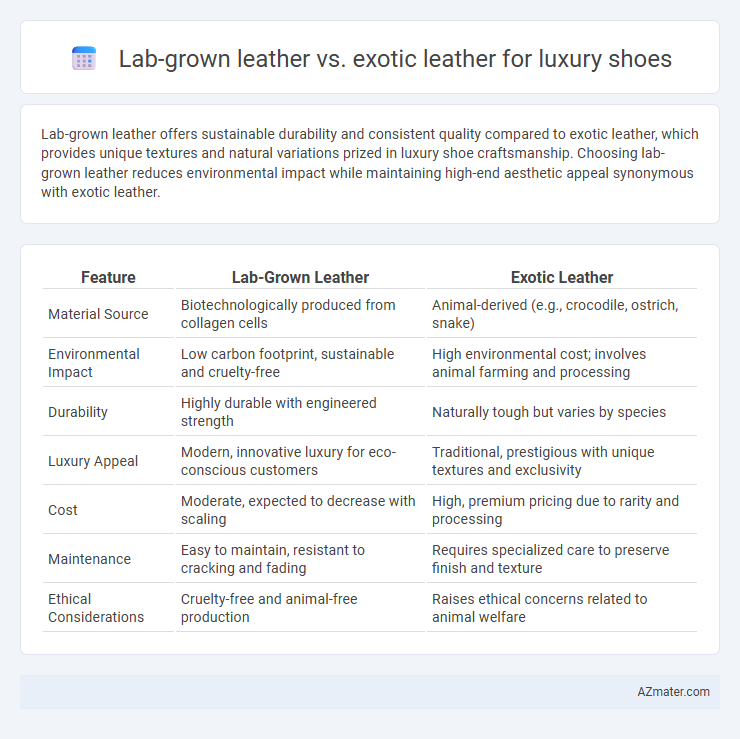Lab-grown leather offers sustainable durability and consistent quality compared to exotic leather, which provides unique textures and natural variations prized in luxury shoe craftsmanship. Choosing lab-grown leather reduces environmental impact while maintaining high-end aesthetic appeal synonymous with exotic leather.
Table of Comparison
| Feature | Lab-Grown Leather | Exotic Leather |
|---|---|---|
| Material Source | Biotechnologically produced from collagen cells | Animal-derived (e.g., crocodile, ostrich, snake) |
| Environmental Impact | Low carbon footprint, sustainable and cruelty-free | High environmental cost; involves animal farming and processing |
| Durability | Highly durable with engineered strength | Naturally tough but varies by species |
| Luxury Appeal | Modern, innovative luxury for eco-conscious customers | Traditional, prestigious with unique textures and exclusivity |
| Cost | Moderate, expected to decrease with scaling | High, premium pricing due to rarity and processing |
| Maintenance | Easy to maintain, resistant to cracking and fading | Requires specialized care to preserve finish and texture |
| Ethical Considerations | Cruelty-free and animal-free production | Raises ethical concerns related to animal welfare |
Introduction to Lab-Grown Leather and Exotic Leather
Lab-grown leather offers a sustainable alternative to traditional exotic leather by using biofabrication techniques to produce durable, animal-free materials that mimic the texture and appearance of genuine alligator or python skins. Exotic leather, sourced from rare reptiles like crocodiles, ostriches, or snakes, is prized for its unique patterns, high durability, and luxurious feel but involves ethical concerns and environmental impacts due to hunting and farming practices. The luxury shoe industry increasingly explores lab-grown leather for its potential to reduce environmental footprint while maintaining the exclusive aesthetic demanded by high-end fashion consumers.
Defining Luxury: What Makes a Shoe Exclusive?
Luxury shoes distinguish themselves through unique materials, meticulous craftsmanship, and exclusivity. Lab-grown leather offers a sustainable, innovative alternative that mimics the texture and durability of exotic leather such as alligator or ostrich, prized for their rare patterns and high status appeal. The exclusivity of exotic leather stems from its natural rarity and heritage, while lab-grown leather gains prestige by pushing technological boundaries in luxury fashion.
The Science Behind Lab-Grown Leather
Lab-grown leather for luxury shoes harnesses cellular agriculture techniques, cultivating animal skin cells in controlled environments to produce sustainable, high-quality material without ethical concerns linked to exotic leather sourcing. This innovative biotechnological process replicates the collagen fiber structure of traditional exotic leathers, offering comparable durability, texture, and flexibility while drastically reducing environmental impact. Advanced tissue engineering ensures lab-grown leather maintains luxury standards, providing an eco-conscious alternative that meets the demands of high-end footwear craftsmanship.
Exotic Leather Origins: Sourcing and Species
Exotic leather used in luxury shoes primarily comes from species such as alligators, crocodiles, snakes, and ostriches, each sourced through highly regulated farms and wild habitats to maintain quality and sustainability. Authentic exotic leather is prized for its unique textures, durability, and natural patterns, often harvested under strict guidelines to meet luxury market standards and legal compliance. Sourcing challenges include ethical concerns and environmental impact, which contrast with the more controlled production of lab-grown leather.
Environmental Impact: Sustainability Comparison
Lab-grown leather significantly reduces environmental impact compared to exotic leather, cutting greenhouse gas emissions by up to 80% and using drastically less water and land. Exotic leather sourcing often involves deforestation, habitat destruction, and high chemical pollution during tanning processes, exacerbating ecological damage. Sustainable luxury shoe brands increasingly prefer lab-grown leather to minimize carbon footprints and promote ethical fashion choices.
Animal Welfare and Ethical Considerations
Lab-grown leather offers a cruelty-free alternative to exotic leather, significantly reducing animal suffering by eliminating the need to harvest skins from endangered species like snakes, alligators, and ostriches. Ethical concerns tied to exotic leather include habitat destruction, illegal poaching, and the inhumane treatment of animals, which are substantially mitigated by adopting cultured leather technologies. Luxury shoe brands increasingly favor lab-grown leather to align with animal welfare standards and meet growing consumer demand for sustainable, ethical fashion choices.
Durability and Performance: Which Lasts Longer?
Lab-grown leather offers consistent durability with enhanced resistance to wear and environmental factors, making it a sustainable alternative for luxury shoes without compromising longevity. Exotic leather, such as alligator or ostrich, boasts natural toughness and unique texture but may require specialized care to maintain performance and prevent premature aging. Comparative studies show that lab-grown leather demonstrates superior uniformity in durability metrics, while exotic leather's lifespan varies based on species and treatment, influencing the choice for long-lasting luxury footwear.
Aesthetic Qualities: Texture, Color, and Uniqueness
Lab-grown leather offers a consistent texture and customizable color palette, enabling luxury shoe designers to achieve precise and uniform aesthetics. Exotic leather, derived from animals like alligator or ostrich, presents naturally unique textures and color variations that convey exclusivity and rarity. Both materials provide distinctive visual appeal, with lab-grown leather emphasizing innovation and precision, while exotic leather highlights organic character and heritage.
Pricing and Market Trends in Luxury Footwear
Lab-grown leather offers a cost-effective and sustainable alternative to exotic leather in luxury footwear, typically priced 30-50% lower while maintaining high-quality aesthetics and durability. Market trends reveal a growing consumer preference for ethical materials, driving a 25% annual increase in lab-grown leather adoption within the luxury shoe sector. Exotic leather, such as crocodile or python, remains a niche market with premium pricing due to scarcity and craftsmanship, but its demand is gradually declining amid environmental and regulatory concerns.
Future Outlook: The Evolution of Luxury Shoe Materials
Lab-grown leather offers a sustainable and ethical alternative to exotic leather, significantly reducing environmental impact and animal cruelty while maintaining the high-quality texture and durability demanded by luxury shoe brands. Innovations in biotechnology and materials science are driving advancements in lab-grown leather, enabling customizable properties such as enhanced breathability and strength that surpass traditional exotic leathers like alligator or python. The future of luxury shoe materials is poised to favor lab-grown leather due to increasing consumer demand for eco-friendly products and stringent regulations on exotic animal sourcing.

Infographic: Lab-grown leather vs Exotic leather for Luxury shoe
 azmater.com
azmater.com